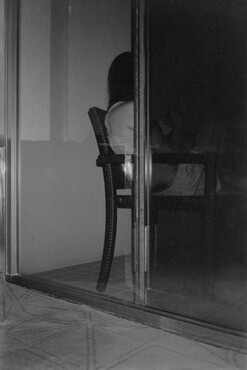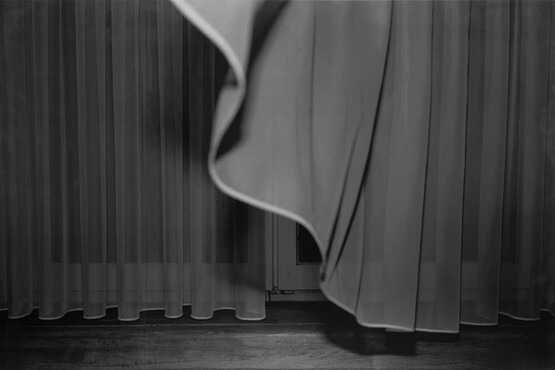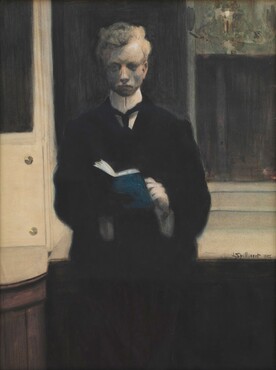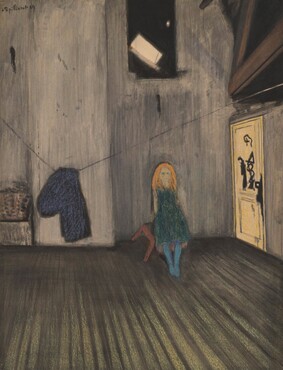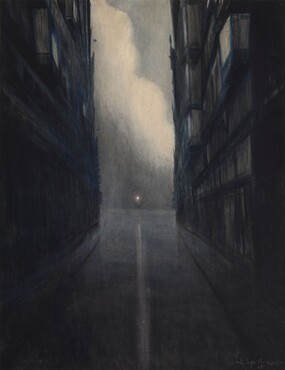Ontdek de collectie
Kunstmuseum Den Haag has a treasure chamber of over 160.000 pieces of art. Here we work on making the highlights from this collection available online.
Dirk Braeckman - Léon Spilliaert:
Night Wanderers
There is an unmistakable artistic affinity between the work of the Belgian artists Léon Spilliaert (Ostend 1881-1946 Brussels) and Dirk Braeckman (Eeklo, 1958). Although Spilliaert worked mainly with ink, pencil and chalk and Braeckman employs photography, their work reveals a shared fascination with the night. Dominated by black and grey, a spectrum of darkness punctuated and emphasised by points of light, their nocturnal gaze transforms their immediate surroundings and impressions into ambiguous dream images that pose more questions than they can answer. Their works seem to emerge from the same emotional world: the mysterious, the elusive and the indeterminate.
With Dirk Braeckman – Léon Spilliaert: Night Wanderers, the Kunstmuseum Den Haag presents the first exhibition to explore the dialogue between these two artists’ works.
Léon Spilliaert
After studying for only a few months at the Academy of Fine Arts in Bruges, Léon Spilliaert worked alone to develop a unique and strongly graphic drawing style. Instead of oil paint, he opted for ink, pastel, watercolour and pencil, with a palette of mostly dark colours: black, grey and blue. Recurring motifs are the sea, deserted streets, hushed interiors and self-portraits, each shrouded in nocturnal shadows.
Spilliaert’s work is related to Symbolism, an art movement that flourished in France and Belgium around 1900 as reaction to the Industrial Revolution: closing their eyes to reality, artists turned their focus inwards. Partly due to his poor health, Spilliaert lived a rather secluded life close to his hometown; journeys elsewhere were restricted to his imagination. As such, the dark colours in his work are interpreted as a reflection of his inner demons.
Dirk Braeckman
Although Dirk Braeckman takes photographs, he thinks and works like a painter. It was already clear in his earliest works that he has little regards for photographic conventions: he resolutely opts for an experimental, painterly approach. For Braeckman, his camera is the same as a painter’s sketchbook. The exposure is only the starting point. The creation truly takes shape in the darkroom. In his unique, large-format prints, overexposure of the photographic paper or wild smears of fixative reveal the artist’s hand.
🎥: Studio Gerrit Schreurs
Exhibition and publication
Dirk Braeckman – Léon Spilliaert: Night Wanderers is the first exhibition to explore the dialogue between these two artists’ work. As in their imagery, the exhibition follows the rhythm of the hours of darkness — from dusk, through the deepest black of the night, to dawn. Around fifty of Spilliaert’s mostly small intimate drawings, with a focus on his early work, are displayed alongside thirty large-format works by Braeckman.
The exhibition will be accompanied by the catalogue Dirk Braeckman – Léon Spilliaert, with contributions by Thijs de Raedt (curator at Kunstmuseum Den Haag) and Steven Humblet (art critic and photography historian). The book, published by Hannibal, will be available from the museum shop from 12 October for 59 euros (Dutch / English, 176 pages, ISBN 978 94 6494 137 1).
*the book is unfortunately sold out
Captions: Léon Spilliaert, Hofstraat, Ostend, 1908, ink wash and coloured pencils on paper, 63.7 x 48.9 cm, private collection, courtesy of Francis Maere Fine Arts, photo Cedric Verhelst
Dirk Braeckman V.B.-C.N.-11, 2011, gelatin silver print, 180 x 120 cm
Léon Spilliaert's work 'Hofstraat Oostende' will be on display until January 12, after which it will travel to an exhibition in New York.

